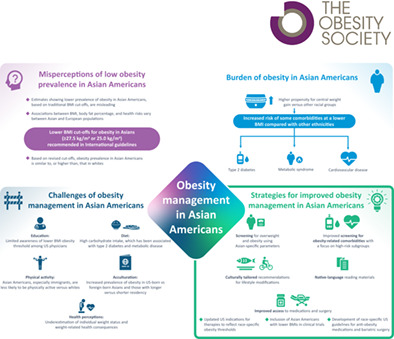- Record: found
- Abstract: found
- Article: found
Obesity among Asian American people in the United States: A review

Read this article at
Abstract
Standard measures of obesity, i.e., body weight and BMI, suggest that Asian American people have a lower obesity prevalence than other racial groups in the United States. However, Asian American people face a unique challenge in their pattern of adiposity with central obesity, which raises the risk for multiple comorbidities, such as type 2 diabetes, metabolic syndrome, and cardiovascular disease, at a lower BMI compared with other populations. Several organizations recommend lower BMI cutoffs for obesity in Asian people (BMI ≥25.0 or ≥27.5 kg/m 2) instead of the standard ≥30.0 kg/m 2 threshold. The risks of obesity and related comorbidities in this population are further influenced by diet, physical activity, perceptions of health, and access to information and therapies. Asian‐specific parameters for assessing obesity should become a standard part of clinical practice. Asian American people should equally be offered subgroup‐specific tailored interventions owing to heterogeneity of this population. Access to medications and surgery should be improved, in part by updating US indications for therapies to reflect race‐specific obesity thresholds and through inclusion of Asian American people of all subtypes with lower BMI values in clinical trials.
Abstract
Related collections
Most cited references73
- Record: found
- Abstract: found
- Article: not found
Appropriate body-mass index for Asian populations and its implications for policy and intervention strategies.
- Record: found
- Abstract: found
- Article: not found


